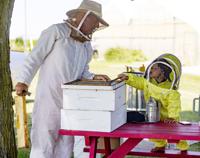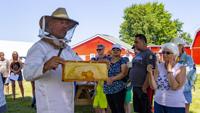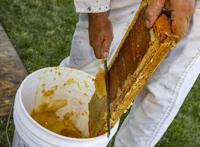Under threat: Niagara Bee Group’s honey harvest highlights the problems facing pollinators
Under threat: Niagara Bee Group’s honey harvest highlights the problems facing pollinators
Niagara Bee Group beekeeper George Scott, dressed in a protective white suit, lifted off the top of a hive and removed the honeycomb frame capped with white wax.
He grabbed a blade and scraped away the wax, unveiling the liquid gold that is the result of the hive’s hard-working bees. Scott, who has been a beekeeper for 53 years, placed the frame with about 16 others in a circular honey extractor pot.
Using a hand crank, the extractor spun with centrifugal force, driving the honey out of the frames and into the side of the silver pot. It takes several minutes depending upon the speed of the hand cranking to complete the process.

Niagara Bee Group beekeeper George Scott with an assistant demonstrates honey extraction during a harvest time event at Apple Hill Apothecary in Niagara-on-the-Lake.
After about a half hour, Scott opened a valve at the bottom of the pot and the light, deep yellow honey flowed into a filter and eventually a bucket.
Niagara Bee Group beekeeper George Scott, dressed in a protective white suit, lifted off the top of a hive and removed the honeycomb frame capped with white wax.
He grabbed a blade and scraped away the wax, unveiling the liquid gold that is the result of the hive’s hard-working bees. Scott, who has been a beekeeper for 53 years, placed the frame with about 16 others in a circular honey extractor pot.
Using a hand crank, the extractor spun with centrifugal force, driving the honey out of the frames and into the side of the silver pot. It takes several minutes depending upon the speed of the hand cranking to complete the process.

Niagara Bee Group beekeeper George Scott with an assistant demonstrates honey extraction during a harvest time event at Apple Hill Apothecary in Niagara-on-the-Lake.
After about a half hour, Scott opened a valve at the bottom of the pot and the light, deep yellow honey flowed into a filter and eventually a bucket.
“It takes about 60 gallons of nectar to make one gallon of honey,” said Scott, as more than 20 adults and children watched wide-eye at how honey is made during the hands-on Honey Harvest Party at Apple Hill Apothecary on Niagara Stone Road in Niagara-on-the-Lake July 26.
The apothecary is one of about 44 locations in Niagara to participate in the Niagara Bee Group’s Host a Hive program.
Kids and adults during the afternoon event also participated in a scavenger hunt, received grab bags, and popsicles were available to enjoy.
“It was very, very informative,” said Gilles Laroche, who accompanied his two grandchildren to the event. “There was a lot to learn.”

Niagara Bee Group beekeeper George Scott shows a honeycomb frame to the crowd.
Scott, is a fourth-generation beekeeper, who recently closed his own commercial bee business in Wainfleet because of financial issues. He quickly pivoted to provide a pollinator service, while also helping preserve Niagara’s ecosystem and educating the public about the industry crisis through Niagara Bee Group.
The problem with bees is pesticides and development have led to a decline in the population, Scott said.
“Bees are under threat,” he said.

Niagara Bee Group beekeeper George Scott scrapes a honeycomb frame during a harvest time event at Apple Hill Apothecary in Niagara-on-the-Lake.
The non-profit Niagara Bee Group launched the Host a Hive program in 2022 to address an ongoing crisis in the bee industry.
In 2021, local beekeepers suffered a loss of more than 50 per cent of their hives. In 2022, Niagara Bee Group lost most of its remaining colonies. Scott said members had to purchase bees from northern Ontario to help repopulate the Niagara bee populations.
“We refocussed to provide pollinator service to neighbourhoods and municipalities, not in a commercial way, just in a private way to support our causes,” said Sandra Ozkur, a member of the organization. “Bees are under threat. It is such a massive problem. But we cannot not try to do something.”
Ozkur said beekeeping is a “dying” industry. But to try and slow down the decline there is a critical need to capitalize on Scott’s experience and information about bees and pass it on to future generations.

A close look at a honeycomb frame with bees at the Niagara Bee Group demonstration at Apple Hill Apothecary in Niagara-on-the-Lake.
“We are just trying our best to keep this alive,” said Ozkur. “These community outreach education sessions helps to provide that information to the people.”
Rudy and Dorothea Enns of Niagara-on-the-Lake wanted to help bees and the environment so they invited Niagara Bee Group to install a couple of hives on their property. The program is designed to require as little maintenance as possible and needs no beekeeping skills during the May to September season.
Also, critical data is taken from the program assisting the industry with a quick view of the health of local bee populations.

Niagara Bee Group beekeeper George Scott displays a honeycomb frame during a harvest time event at Apple Hill Apothecary in Niagara-on-the-Lake.
“This is important,” said Dorothea, whose property is near a peach orchard. “We wanted to save the bees. The plants need to be pollinated in the spring in order for us to have our excellent quality fruit. I didn’t know it would work out or not.”
After a season, one hive was successful, the other wasn’t, she said. And nobody knows exactly why, although they have suspicions, she said.
Still, in the fall she received several jars of honey from her hive as part of the agreement with Niagara Bee. The other half of the honey goes to a non-profit organization.
This year, said Dorothea, their hives are “much more successful.”
Scott praised the Enns location as being an almost perfect spot to host a thriving bee hive with a mix of plants to pollinate and Lake Ontario nearby for critical water needs.
Assisting Scott during his honey-making process was Jolene Drouin, a maple farmer and beekeeper in her third year, who said Niagara Bee Group’s main goal is to educate as many people as possible in biodiversity.
“We are not just an organization about the honey bee,” said Drouin, who is from Niagara Falls and brought her two young children, Rocky and Moses, for much needed assistance as they interacted with the other children and adults. The group is also involved in protecting the environment, eagle nesting, quail and blue bird programs.
She provided the audience with interesting facts about the honey bees, which are not native to Ontario, such as they don’t sting unless they feel threatened and most of them are female. When smoke is used, it disrupts a pheromone they emit when they feel threatened, calming them down, she said.
“Bees are more focused on their work,” she said, although she has felt a bee sting or two.
She also told the gathering how to distinguish if honey is “real” between store-bought containers or freshly churned honey. Real honey usually crystallizes at the bottom of the container, said Drouin.
Later, she said the honey harvests are “some of the sweetest events we do” usually about once or sometimes twice a year depending upon how productive the bees have been.
“This is really important to me,” said Drouin. “(Niagara Bee Group) came together and saw a need in the community, a need for people to contribute. We bring this unique opportunity where you can be stewards of the land.”






